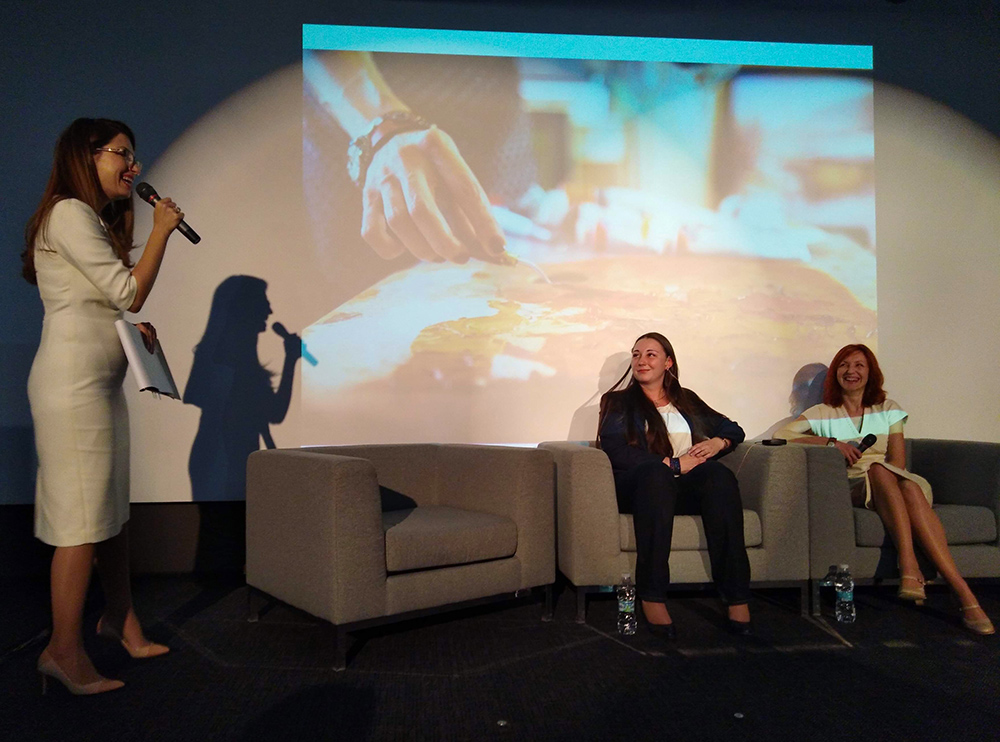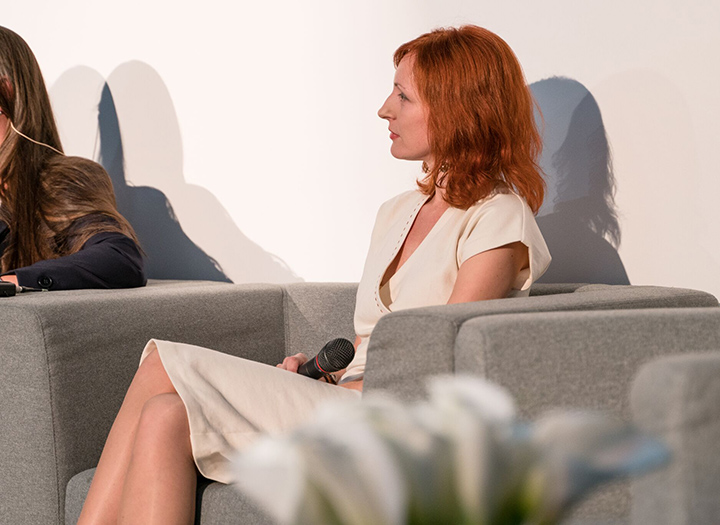
Women.Speak.Live 2018 conference
Last year, for the first edition of Women.Speak.Live., Aneta Savova invited me to be one of the presenters and I spontaneously said ‘yes’. But then some personal stories unfolded, had travels abroad for medical examinations, so I had to cancel my participation. This year Ani invited me for a second time and I couldn’t say ‘no’ to her. To be honest, both times my stomach clenched – reactions like ‘what will I say to these kind people there’ and similar inner barriers. But apparently I had reached a stage where I absolutely realized I needed to go out of my comfort zone thus I stamped my foot and I told myself that this was the purpose of such forums: to share how you go beyond yourself, how you grow, how you act despite the fear…
The event passed by. It felt inspiring and cozy. And it was undoubtedly enriching. Below are some of the things we discussed during our session (where I was a co-panelist of Lidia Rousseva, Flight Control Officer (in the middle). Here I share only my answers.

Ani: When are you high in the sky? When do you have the unlimited feeling that you can achieve everything?
Alex: When I start an exciting project and I know that it will turn out amazing despite the efforts its realization will cost me… This can be a specific painting or an exhibition with a specific concept, or when my painting turns into a book cover and my team and I work on the cover design… Or when I have a clear goal and I have the drive to make the steps for achieving it… In such moments I have a feeling of euphoria that all is where it should be, that I know who I am and where I am going… And the process is fun regardless of the end result… This is when my wings are spread wide…
Ani: Do dreams change with maturity?
Alex: Dreams are a dynamic matter – a function of our growth and the experience we acquire. Thus it is normal to dream for different things during different periods in our life… For example, when I created the Acrista Art brand and the website acrista.com, and I was emerging as an artist, I had more traditional art dreams: I dreamt to enter more galleries, to do exhibitions…
Then I left the office environment and I dedicated completely to creating art. Social media emerged and I started dreaming about reaching out to more people, creating various projects, realizing commissions…
Now, fifteen years after the beginning, I am entering a new dreaming period: I dream for a larger scale, for a bigger studio, for larger canvases, for a larger market… overall, for wider wingspread – a flight in the heights.
In this line of thought, the best way to dream is when you are rested after completing (in my case) some inner work and when you have tidied and cleared up. This frees resources for you to wish for new things to come your way.

Ani: Both are women with occupation which was considered male for many years. Are there any stereotypes still? How do you overcome them? What are the myths about your occupation?
Alex: I think we all know what are the myths about artists: they are some capricious, misunderstood rebels with beards and berets which blissfully paint something all day long, unaffected by the everyday existence; painters paint only when they have inspiration; a painting is not a product at all… These stereotypes come from the times when the painters were predominantly men, when the women didn’t have access to art except as models and stirring pigments for the men artists. Tt is only now that the information about women artists from the Renaissance starts to come to light. An information which was not relevant for a long time.
I need to point out that now is a beneficial time to be a freelancer woman artist and it helps a lot to destroy the stereotypes. Nowadays the creation of a quality and distinct product and the knowledge of technologies are already a good foundation for a successful start.
Maybe even nowadays the artist occupation still sounds exotic owning to the fact that people don’t really know to a great extent what artists do daily. From my point of view, this is a painstaking work and the creation of a painting is only a small part of the process. For example, I communicate with clients and answer emails, questions and comments daily; I organize the shooting of the paintings, process images, publish on my website and in various online platforms; I organize events, write and select texts; I prepare catalogues, calendars and other editions; I take care of the finance and work with suppliers – designers, importers of art materials, framing ateliers, couriers. the orders and sales for abroad are a separate category to be managed… Overall, if I can divide the process to creative part and administration (business part), they are almost 50% – 50%.
Of course, my view point is the one of an outsider (as I have 10-years experience in a corporate environment). This helps me to overcome the stereotypes in the art industry. And the behavior beyond the stereotypes shows the others that things can be done differently.

Ani: What is the greatest challenge for you?
Alex: The first serious challenge you face when you become a freelancer is the insecurity. To have fixed expenditures, but without knowing when you will have the incomes that will cover them. This is a shock familiar only to people who have experienced it… With time you learn to juggle more successfully, but this remains a constant challenge.
Another challenge I can think of is to set your own goals. When you work for a company you goals are more or less aligned with the company goals. When you are self-hired you get up in the morning and you are the one setting the direction. This is a challenge.
Another challenge: how you cope with refusals, critique, dislikes…
And one more I am facing right now: how do you go beyond yourself when you have set high standards? I make a lot of efforts for things to happen, to be well thought of, to have all the details right, and to be aesthetically pleasing… And now I am working on the preparation of my next exhibition and I face the challenge to do better than I did in my previous one…

Ani: When are you brave?
Alex: Actually I have no clue if I am brave… Maybe I am brave when I am on stage because being a well disguised introvert every emergence from the perimeter around my easel and my comfort zone respectively, is bravery. Maybe it is bravery to persist and do the things I love despite the obstacles, difficulties, and the moments when nothing happens…
But isn’t bravery strange … you cannot say about yourself ‘I am brave’ almost never. It happens through the eyes of the others(when people come to my studio or to an exhibition and tell me: ‘you inspire us so much’, ‘you are such a good example’, ‘keep doing what you do’). In such rare moments I manage to look at things from the outside and realize what I actually achieve in our conditions…
When I think about it though, one of the things requiring bravery which I realize are the commissions (especially for abroad)… The commissions that I do are paintings for specific places, based on an already sold painting or a series of paintings.
Making such commitment is bravery, because I never know whether I will manage to ‘see’ though the eyes of the client. Whether I can both be true to myself and meet the client’s expectations. Thus when I work on it I feel anxiety whether the final result will be approved. But to be brave pays back, because the trust of complete strangers living thousands of kilometers from me who (in some cases) haven’t seen me or spoken with me (Halleluiah technologies) is extremely satisfying and motivating. The commissions of paintings are a good example that you can be both scared and brave.
Ani: Is the artist a free soul and does she have a business orientation at all?
Alex: We all have dreams, but it is more interesting what dreams become… Yes, every artist wants to do only creative things… But it is a fact that if one wants to realize her potential, if she wants to find a market niche for the things she creates, there is a business aspect in the talent realization and it cannot be ignored.
Actually, the first thing that needs to happen is a ‘brain breakdown’ – to accept that this IS a business. Then comes the need for clear objectives and business thinking, a skillful balancing between the business and the creative parts, having your own success criteria, analysis of the business and the market (the intersection point between what the artist can and what the market is looking for), and if necessary – diversification of resources, search for another market etc.
In general, creative people don’t have business acumen. Thus it is vital they delegate to someone else to look after this part. At the beginning it can be people from their friends circle and maybe a company afterwards. But this will help to develop brand, strategies, right positioning and eventually it will allow the artist go grow as an artist.
Unfortunately, over the years I was growing up as an artist, I witnessed how so much talent around me (in various areas) failed to unfold due to the lack of business thinking. It was really a shame.
Ani: If there is an advice you would share with any woman, what would that be?
Alex: The message I often write down in my art catalogue is ‘Dream boldly and achieve with ease!’ but the truth is that between the dreaming and the realization there is so much work that needs to be done! And it’s mostly inner work… because the personal development is the foundation for the professional development. Thus my advice is ‘get to know, analyze, and unravel yourselves’. The awareness, the understanding what are your strong (or weak) sides will give you the opportunity to define your own success criteria, the direction you want to go to, and what you want from life in general. This is the first step and it is a solid foundation after which it will not necessarily be easy, but it will be a good starting point for success.





